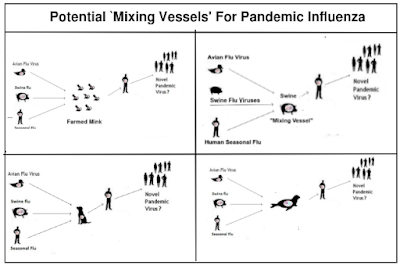
#17,755
Last July Finland reported an outbreak of H5N1 in 20 fur farms (foxes, raccoons, mink), and after a slow initial response, on August 1st their food safety authority announced the decision to cull all of the mink housed at 3 H5N1 affected farms.
A little more than a week later (Aug 8th), Finland's Institute for Health and Welfare (THL) released a strong statement urging the Food Authority to take more decisive actions, warning:As for the tens of thousands of infected foxes and raccoons, they stated that `Decisions to cull other animals will be made on a case-by-case basis'.
Although mink is considered to be the most problematic animal species in terms of avian influenza virus infections, there are also risks associated with bird flu epidemics in dense, large animal populations of foxes and other fur-bearing animals, that the virus becomes more adaptable to mammals.
A week later Ruokavirasto pledged to test all of the fur farms in the country (n > 400), but stated it would take months to complete. Two months ago (Sept 13th) the Food Safety Authority finally ordered All Animals From Bird Flu Infected Fur Farms Be Euthanized.
Last week, after 60 days of testing mink farms, only 3 additional farms were reported positive, and Ruokavirasto stated that they were moving on to test fox and raccoon farms.
Today we learn from a press release, that in the first week of this new survey, that 10 farms tested positive. Since this was out of only 38 farms tested - that is a much higher percentage (26.3%) than anyone was expecting.
Bird flu was found in ten fox farms
November 10, 2023
In the mapping of fox and raccoon kennels, which started quietly, bird flu has been found in ten kennels. Infection centers are located in the five provinces where cases of bird flu have occurred in the past. So far, 38 fox and raccoon kennels have been examined in the survey. All of these have had foxes and a few also have raccoon dogs.
The mapping of the fox and raccoon kennels really started in week 45. More bird flu has already been found there than in the mink mapping carried out earlier, where bird flu was found in only three kennels. Possibly foxes are more sensitive than minks to getting infected with bird flu, or the bird protection of fox farms has not been as good as that of mink farms, or there have been more fox farms in areas where there have been many bird flu infections of wild birds.
The shelters found to be positive in the fox and raccoon survey are located in Ostrobothnia, Southern, Central and Northern Ostrobothnia and Satakunta. The locations of the shelters and animal species information will be published later on the Food Agency's website, as long as the regional administrative agency has first been in contact with those concerned.
In bird flu mapping, blood samples are taken from foxes and raccoons in fur farms. The samplers are mainly municipal veterinarians. The Regional Administrative Agency of Western and Central Finland is responsible for organizing the sampling and coordinating the mapping for the whole of Finland. The survey targets approx. 330 fur farms that have foxes or sable dogs or both. Before the survey began, bird flu had been found in 28 fur farms with foxes and/or raccoons. In total, bird flu has now been found in 42 fur farms.
In the Food Agency's laboratory, the blood samples are first tested for antibodies caused by the Influenza A virus using the ELISA method. Antibody-positive samples are confirmed by the HI method ( hemagglutination inhibition ). The method examines the binding of the antibodies in the sample to the HA protein of the influenza A virus, which is the same subtype as the virus isolated from fur farms. The test accurately identifies antibodies to the H5 virus.
The Food Agency will order animals to be euthanized from fur farms whose samples show antibodies to H5 bird flu.
The detection of H5N1 now in 42 fur farms in Finland is highly concerning, but it begs the question, how many other fur farms around the world are similarly infected?
There is often a good deal of resistance to testing - particularly when animals appear healthy - and in many parts of the world, the resources simply aren't available. Even Finland is struggling to test all of their farms.
Fur farms aren't the only potential flash point for the emergence of a pandemic flu strain - but like live poultry markets - it is a venue over which we can exercise some control.
